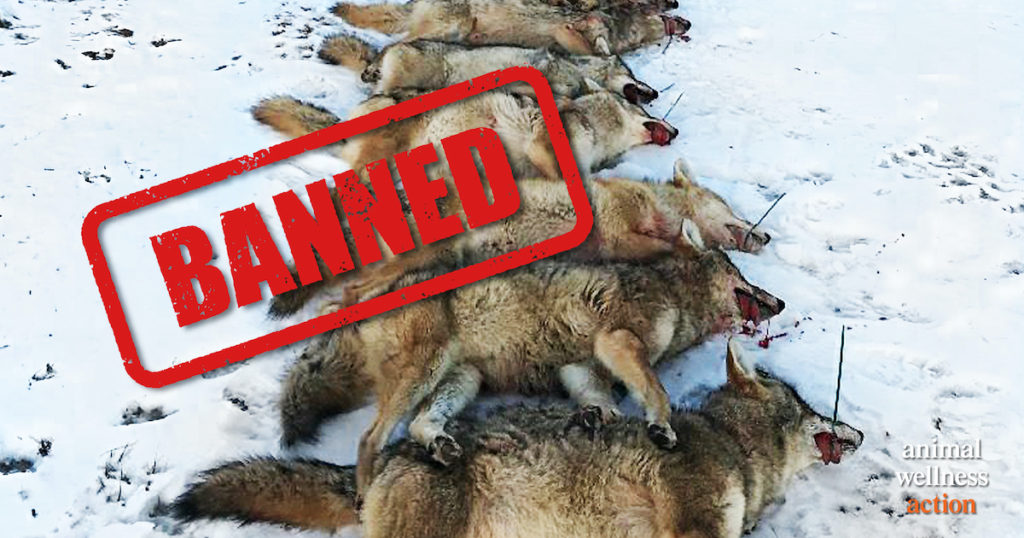
Washington State Bans Wildlife Killing Contests
Yet More Work Remains in a State Where Bears, Wolves, and Mountain Lions Are Under the Gun
by writing Gov Inslee to let him know you want conservationists, ecologists, and wildlife advocates appointed to the commission.
- Lain Kahlstrom
The Washington Fish and Wildlife Commission rightly outlawed wildlife killing contests last week with a 7-2 vote, making it the seventh state to forbid these competitions. In the West, Arizona, California, Colorado, New Mexico, and Washington bar massacring coyotes, bobcats, foxes, and other wildlife in spectacles that violate all norms of modern wildlife management. Kudos to the supermajority of Commissioners for instituting this policy.
It’s hard to believe that in 2020, there are still hundreds of wildlife killing contests occurring from Washington to Maine. With new, peer-reviewed reports showing a dramatic decline in wildlife populations due to habitat loss and degradation, poaching, state and federal predator control programs, roadbuilding and automobile collisions with animals, and other anthropogenic effects, wildlife cannot afford more gratuitous killing. When contest organizers try to obscure their activities from view, that means that even they understand they are doing something offensive and unpopular with the masses.
This policy change played out as it should have, with the state’s Fish and Wildlife Commissioners forbidding the kill contests. But this hasn’t been the way good decision-making has come about in the past in Washington. The state has a troubled history of allowing trophy hunting and trapping to drive policy-making. It took citizen initiatives to ban bear baiting and the use of dogs to hunt bears, mountain lions, bobcats and lynx, and to bait bears. Four years later, in one more ballot initiative in 2000, citizens put a stop to the use of steel-jawed leghold traps and other body-gripping traps, and the use of two poisons for predator control.
Neither set of reforms should have required votes of the people. Elected officials and appointed commissioners should have been able to read the mood and values of the electorate and taken affirmative action. Instead, the Department of Fish and Wildlife and the Commission had been abetting inhumane practices and working to justify and defend them. It’s a case of industry capture in the extreme, and the lines between the trophy hunting industry and the government actors are blurred and even blended together.
In the serial ballot measures that amount to bold rebukes of the state agency’s decision-making, it should have caused soul-searching on future wildlife reform matters. But the state has regrettably worked for two decades to try to unwind what the voters decided. They tried work-arounds to subvert the initiatives, especially the one restricting hounding and baiting. The state has liberalized cougar hunting dramatically, and it has, for many years, deputized hunters to handle so-called problem cougars. On timber company lands, ostensibly to protect tress from girdling by bears, it has authorized the use of bait and dogs to kill the bruins.
Its management of wolves has also drawn international criticism. Washington is home to fewer than 150 wolves, who are classed as endangered and still struggling to find footing on their native lands. Wolves stand accused of killing or injuring a small number of cattle each year, and the Department of Fish and Wildlife has acted as contract killers for the private ranchers. In truth, most of the wolves killed have come at the urging of a single rancher — Len McIrvin and the other family members at the Diamond M ranch, located near the Canadian border in Stevens County. He is the only rancher with repeated conflicts with wolves, and the Department is all too eager to kill wolves to satisfy his demands, as opposed to standing firm in their requirements for non-lethal methods.
Yet there is an opportunity, finally, to turn this around, and the state’s forward-thinking governor, Jay Inslee, can help usher in a new management team when it comes to wildlife protection. Inslee has repeatedly scolded the agency for its lethal maneuvers against wolves and urged more vigorous use of non-lethal management methods. Of the nine seats on the Commission, Inslee can now select four new members, remaking the Commission and enabling it to reflect the values of the people of Washington.
The Commission is the body that hires and fires the Director of the Department of Fish and Wildlife, and the current director, Kelly Susewind, has been no friend to wildlife. There are no shortage of conservation and humane-minded people who understand that wildlife are in peril and require our creative solutions.
So, yes, let’s celebrate the Commission’s 7-2 vote to ban wildlife killing contests. But let’s remember, that practice is so extreme that it’s hard to believe anyone is on the other side. The test in the future is if the state can have a commission that allows wildlife to flourish, protects their habitats, and manages the inevitable conflicts between people and wildlife. For more than a century, we have proved we are adept at persecuting wildlife. In the decades ahead, we must demonstrate our ability to protect them.
Lain Kahlstrom is the Director of State Affairs for Animal Wellness Action.
